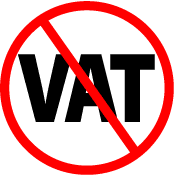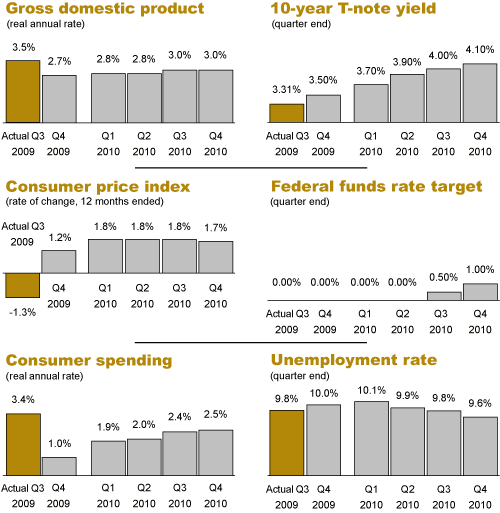|
November 4, 2009
VAT Chance
Written by Jeff Thredgold, CSP, President, Thredgold Economic Associates
No shortage of really bad ideas find(s) their way around the nation’s capital on a regular basis. One of the worst is now rearing its ugly head again…
…the VAT, or value added tax, has been mentioned by all too many American politicians and Democratic political advisors in recent weeks as one way to help address the incredible surge in government spending scheduled to take place in coming years
In the eyes of long-time politicians, what could be better than a nifty way to raise a vast amount of new tax revenue without having to raise income tax rates? (Note: income tax rates are already scheduled to climb over the next few years as the Administration lets most of the 2001 and 2003 tax cuts expire for families making more than $250,000.)
 What could be better than a tax where it is very simple to raise the tax rate at any time, without most taxpayers noticing? What could be better than a tax where it is very simple to raise the tax rate at any time, without most taxpayers noticing?
A Largely Hidden Tax
A VAT tax is a tax on consumption similar to a national sales tax. But it’s not just paid at the cash register. It’s levied at every stage of production. So all businesses involved in making a product or performing a service would pay a VAT. And then the end-user—such as the retail customer—ponies up as well (CNNMoney.com).
Stated another way, the allure of a VAT for politicians is that it applies to every level of production or service, rakes in piles of money, and is largely hidden from those who ultimately pay it—namely, consumers (The Wall Street Journal).
Proponents
House Speaker Nanci Pelosi, U.S. Treasury Secretary Tim Geithner, and former Federal Reserve Chairs Paul Volcker and Alan Greenspan have suggested now may be a good time to consider implementation of such a program. John Podesta, an Obama advisor and president of the liberal Center for American Progress, has been as vocal as any calling for the implementation of a “small” VAT tax.
Much of the current discussion about the VAT suggests a rate near 4% or 5% might provide sufficient funding to help meet some of the needs of rapidly expanding government. Using 2008 data, a VAT of 5% would equal a tax increase of $315 billion on all American consumers, or roughly $2,670 on every household, including the poor and middle-class (Investor’s Business Daily).
Once in place, a VAT can be increased without much fanfare. For example, Mexico’s legislature recently increased its value added tax rate from 15% to 16%. For that matter, it also raised the top income tax rate for high earners from 28% to 30% (Financial Times).
Eurosclerosis
European nations are well-known for their high VAT taxes, with most nations in a range of 15% to 25%. Larger European nations have VAT rates around 19%. These rates are in addition to income tax and corporate taxes…
…any wonder why the European economy typically trails that of Asia and North America in economic vibrancy?
Federal Government spending has averaged 20.2% of GDP over the past 20 years. Federal tax receipts have averaged 18.2% during that same 20-year period. The 2.0% average difference has been the budget deficit.
Various forecasts have federal spending approaching no less than 25% of GDP in coming years, tied in large part to surging health care costs if Obama and Pelosi have their way…
…A VAT is not the answer. The answer is for national politicians to get a grip on spending.

|

|
Quarterly economic survey
The USA TODAY economic survey of 46 top economists was conducted October 22-28. Median estimates through Q4 2010:
|
USA TODAY • Monday, November 2, 2009
 |
Survey participants: Tucker Hart Adams, The Adams Goup; Nariman Behravesh, IHS Global Insight; Richard Berner, Morgan Stanley; Jay Brinkmann, Mortgage Bankers Association; Bill Cheney, John Hancock Financial; David Crowe, National Association of Home Builders; J. Dewey Daane, Vanderbilt University; Richard DeKaser, Woodley Park Research; Rajeev Dhawan, Georgia State University; William Dunkelberg, Boenning & Scattergood; Michael Englund, Action Economics; Lyle Gramley, Soleil Securities Corp.; Ethan Harris, Bank of America-Merrill Lynch; Maury Harris, UBS; Stuart Hoffman, PNC Financial Services Group; Dave Huether, National Association of Manufacturers; Dana Johnson, Comerica Bank; Hugh Johnson, Johnson Illington Advisors; Dean Maki, Barclays Capital; Ken Mayland, ClearView Economics; Dan Meckstroth, Manufacturers Alliance/MAPI; Jim Meil, Eaton; Robert Mellman, J.P. Morgan; George Mokrzan, Huntington National Bank; Joel Naroff, Naroff Economic Advisors; Frank Nothaft, Freddie Mac; Donald Ratajczak, Morgan Keegan; Martin Regalia, U.S. Chamber of Commerce; David Resler, Nomura; Chris Rupkey, Bank of Tokyo-Mitsubishi UFJ; John Ryding, RDQ Economics; Joshua Shapiro, MFR; Robert Shrouds, DuPont; Allen Sinai, Decision Economics; James Smith, Parsec Financial Management; Sean Snaith, University of Central Florida; Sung Won Sohn, California State University; Neal Soss, Credit Suisse; Diane Swonk, Mesirow Financial; Jeff Thredgold, Thredgold Economic Associates; Bart van Ark, The Conference Board; Chris Varvares, Macroeconomic Advisers; Mark Vitner, Wells Fargo; Brian Wesbury, First Trust Advisors; Lawrence Yun, National Association of REALTORS; Mark Zandi, Moody's Economy.com
 |
• Email this article to a friend
• Learn about econAmerica, Jeff’s latest book
|
|
Subscribe to the Tea Leaf
Like what you just read? Have Jeff Thredgold’s Tea Leaf emailed to you free each week. Subscribe today.
|
|
|

“Tea”ser
Smoking is one of the leading causes of statistics.

“Tea”stimonial
“I want to sincerely thank you for your excellent presentation given at The Powder Coating Institute Annual Meeting in San Antonio. Your economic outlook was both educational and entertaining. I also thank you for taking the time to meet with members both before and after your presentation. You were great to work with, a true professional in every sense of the word!”
Gregory J. Bocchi, Executive Director
The Powder Coating Institute
• More testimonials
Invite Jeff Thredgold to speak at your next conference, meeting, or client function
If you like the Tea Leaf, you’ll love Jeff Thredgold’s live presentations. Jeff takes your audience on a timely, engaging, and entertaining tour of the U.S. economy and financial markets. Debunking some of today’s most common economic myths, he offers a clear picture of how the American economy is really performing and what that means for the future of your finances.
• ***Watch Jeff Thredgold’s new demo video.***
• Download more information that you can e-mail to other decision makers.
• See Jeff Thredgold’s speaking calendar.
• Tell us about your event using our online form and we will contact you. Or, is there an individual in your organization you would like us to contact?
• Give us a call at 1-888-THREDGOLD (847-3346) to ask about Jeff’s availability and pricing for your event, or for any other information.
|
